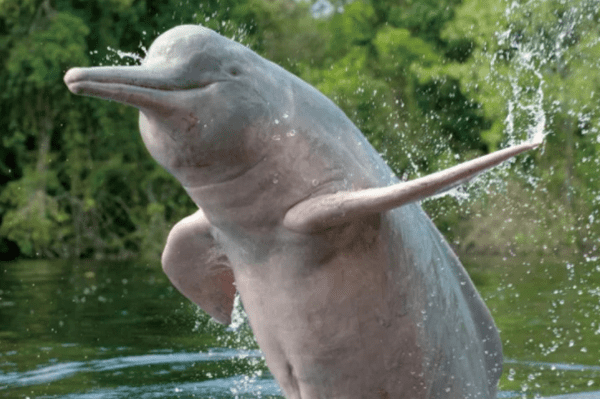Inia geoffrensis
IUCN
LCBasic Information
Scientific classification
- name:Inia geoffrensis
- Scientific Name:Amazon porpoise
- Outline:Cetacea
- Family:S.Pleurodontidae
Vital signs
- length:1.8-2.5m
- Weight:85-160kg
- lifetime:No verification information
Feature
The largest dolphin in the world
Distribution and Habitat
Known distribution ranges from the Orinoco River in South America to all major rivers in the Amazon Basin, Venezuela, Peru, Ecuador, Bolivia, Colombia, Guyana and Brazil. In some areas, it has been found more than 3,000 kilometers inland from the coast. It is most common at the confluence of major rivers and tributaries, below rapids, and close to the coast. In the dry season (August to November), it is only found in the mainstream and tributaries; in the flood season (December to June of the following year), it will enter the flooded jungle and grassland and wander among the trees. When the floods recede (starting in July), the water level can drop by as much as 10 meters, so it may be stranded in ponds.
Appearance
The Amazon River Dolphin is also known as the Amazon River Dolphin. It is a freshwater dolphin with a prominent forehead and a melanin that can change shape at will. The crescent-shaped blowhole is located to the left of the center of the body. The dorsal ridge extends forward and backward from the ridge, which replaces the dorsal fin. The large pectoral fin is paddle-shaped. The body is fat and colorful. The body color is bright pink, blue-gray, or gray, yellow or impure white. The ridge and dorsal ridge replace the dorsal fin. The large pectoral fin is paddle-shaped. The beak is long and fat. The fat body gradually shrinks toward the tail. The tail fin rarely rises out of the water. The beak is slender and slightly curved downward. There are short bristles on the upper and lower jaws, the lip line is raised, the neck is free to move, and the neck wrinkles are sometimes very long, with uneven rear edges. The pectoral fins are curved and pointed at the end. The body color is blue-gray
Details
The scientific name of the river dolphin is Inia geoffrensis. It is the largest dolphin in the world and one of the few dolphins that is still common. During the dry season, river dolphins gather in groups of about a dozen; in other seasons, they live in groups. The sound of the puffs can be loud or very high, sometimes up to 2 meters, but they are usually slow and calm, as if sighing, and the degree of closeness varies from region to region. They are most active in the early morning and dusk, and can be seen chasing, nibbling and waving their pectoral fins. Usually only the forehead ridge and fumarole appear, and then part of the back appears. River dolphins are slow swimmers and are good at finding food in the dark waters of the Amazon. Pufferfish mainly feed on fish, crayfish and other small animals, relying on vision, hearing and echolocation to find food. It swims slowly, can make small jumps, and swims close to ships.

The river dolphin is relatively easy to see compared to other freshwater dolphins, but due to its living habits, thirsty river tributaries causing stranding, and human damage to its living environment, the population of the river dolphin is declining.
This species is currently classified as "vulnerable".
Protect wild animals and eliminate wild game.
Maintaining ecological balance is everyone’s responsibility!








